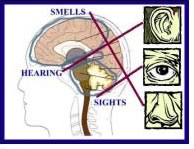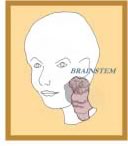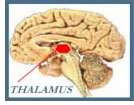

1/2006

by John P. Eberhard,
FAIA
Founding President, Academy of Neuroscience for Architecture
Men ought to know that from nothing else
but the brain comes joys, delights, laughter, and sports, and sorrows,
griefs, despondency, and lamentations. And by this, in an especial
manner, we acquire wisdom and knowledge, and see and hear and know
what are foul and what are fair, and what are bad and what are good,
and what are sweet and what are unsavory… In
these ways I am of the opinion that the brain exercises the greatest
power of the man.
— Hippocrates, fourth century B.C.
 If you enter the Cathedral in Amiens at twilight while an organ is playing
and find that your “heart skips a beat,” it’s because
your brain—not your heart—has filled you with awe. Cells
in your brain are gorging themselves with a sudden flush of blood, raising
your temperature, quickening your pulse, and flooding you with memories.
Light flooding through stained glass windows is stimulating the V4 area
of your visual cortex. Bach’s music is vibrating within the cochlea
of your inner ear and sending signals to the auditory cortex. The musty
smells of centuries past register unconsciously on the olfactory neurons
at the bridge of your nose. You are experiencing architecture.
If you enter the Cathedral in Amiens at twilight while an organ is playing
and find that your “heart skips a beat,” it’s because
your brain—not your heart—has filled you with awe. Cells
in your brain are gorging themselves with a sudden flush of blood, raising
your temperature, quickening your pulse, and flooding you with memories.
Light flooding through stained glass windows is stimulating the V4 area
of your visual cortex. Bach’s music is vibrating within the cochlea
of your inner ear and sending signals to the auditory cortex. The musty
smells of centuries past register unconsciously on the olfactory neurons
at the bridge of your nose. You are experiencing architecture.
And you—not your friend standing next to you or your spouse just joining you—are having a unique experience that only you can have. Your brain might look just like theirs to a casual observer, but it is not. Your brain was formed by the DNA of generations of ancestors once your mother and father conceived you. From the time of your birth to this instant in Amiens, all of the networks of your brain have been formed and reformed as you experienced the world. What a marvelous creature you are!
Over the next few months, I would like to take you on a journey into new territory. When I first came around the intellectual bend in my own reading to discover that there was this vast new knowledge called “neuroscience,” I felt like Lewis and Clark must have felt when they first saw the Rocky Mountains. Just as they had no idea that there was such a mammoth formation in the Northwest Passage, I had no idea that my exploration of human experiences with architecture would discover this enormous and still rapidly growing body of research.
In 1995, then-American Architectural Foundation President Norman Koonce, FAIA, and Syl Damianos, FAIA, urged on by Dr. Jonas Salk, had made me the director of discovery for the foundation. None of us knew where this expedition might lead us, but now there is an Academy of Neuroscience for Architecture, building on my astounding discovery of neuroscience. The academy, founded by AIA San Diego in 2003, seeks to build intellectual bridges between neuroscience research and architectural practice. These 12 articles will be another attempt by me to help with this bridge-building effort.
The difference between the brain and the mind
You use the word “mind” every day. You might say, “I
think I am losing my mind,” or “never mind,” or “I
can’t keep my mind on what I am doing.” But are you really
describing mind? It’s not a synonym for “brain”; it’s
not even a thing, so you can’t really lose it the way you might
lose your wallet. The mind is a process that uses the organ of the brain
as its instrument. It will be important to “keep this in mind” as
we proceed on our journey together. The next section describes the brain,
but how our minds use this most complicated thing in the universe is
the stuff of future articles. For now, suffice it to say that no other
living creature has a mind like yours: Only humans have the ability to
think about the past, contemplate the future, and be aware of being aware
in the present.
As Rita Carter tells us in her book Mapping the Mind (University of California Press, 2000), the brain is “as big as a coconut, the shape of a walnut, the color of uncooked liver, and the consistency of chilled butter.” It has two halves called hemispheres, covered with a wrinkled gray tissue called the cerebral cortex. If this tissue of wrinkled gray matter were unfolded it would be about 30 inches square and about the thickness of a table napkin. Lodged within its six thin layers are one hundred billion cells; ten billion of these cells are neurons.
 Neurons are
the primary working components of the brain—something
like transistors in the computer you are using to read this. However,
unlike transistors, the neurons are living components that are constantly
changing, forming networks, and receiving signals from other neurons.
They sometimes make mistakes, sometimes are damaged by disease or accidents,
and sometimes are dying. Neurons are assembled in the brain in families
(or areas), each with a special responsibility. Some areas make it possible
to see, others to hear or smell, etc. (We will discuss neuron areas in
future articles.)
Neurons are
the primary working components of the brain—something
like transistors in the computer you are using to read this. However,
unlike transistors, the neurons are living components that are constantly
changing, forming networks, and receiving signals from other neurons.
They sometimes make mistakes, sometimes are damaged by disease or accidents,
and sometimes are dying. Neurons are assembled in the brain in families
(or areas), each with a special responsibility. Some areas make it possible
to see, others to hear or smell, etc. (We will discuss neuron areas in
future articles.)
Components of the brain
I said earlier that the brain has two hemispheres, often called the left
brain and the right brain. They do have different functions. The left
brain is calculating, communicative, and able to conceive and execute
complicated plans (something you do as an architect). The right brain
is gentle, emotional, and more at one with the natural world—probably
important to those who believe in “green” architecture.
These two halves are bound together by a band of nerve fibers called
the corpus callosum, which provides a bridge for instant messages between
the two. The corpus callosum is why you see only one image, even though
your left eye sends signals to the right hemisphere and the right eye
to the left hemisphere.
If you opened up the brain and looked between the hemispheres you would find these other special components:
 The
brainstem is the most ancient
part of the brain—it
evolved more than 500 million years ago. The brainstem is formed from
the nerves that run up from the body via the spinal column carrying
information from the body into the brain. Various collections of cells
in the brainstem determine the brain’s general level of alertness
and regulate the vegetative processes of the body, such as breathing,
heartbeat, and blood pressure (the homeostatic system).
The
brainstem is the most ancient
part of the brain—it
evolved more than 500 million years ago. The brainstem is formed from
the nerves that run up from the body via the spinal column carrying
information from the body into the brain. Various collections of cells
in the brainstem determine the brain’s general level of alertness
and regulate the vegetative processes of the body, such as breathing,
heartbeat, and blood pressure (the homeostatic system). The
hippocampus is the name for this
busy piece of the brain that comes from the Greek word for sea-horse,
because it is shaped like a seahorse. If I tell you my phone number
(seven digits) this information is first recorded on your hippocampus.
Five seconds later it is moved into long-term memory. However, if
I were to ask you what you had for breakfast before these five seconds
were up, your mental effort in recalling coffee and doughnuts (moving
this information out of long-term memory to the short-term memory
of the hippocampus) would erase my phone number before you had a
chance to move it. Most of the activities of forming and recalling
memories (such as remembering what it was like to visit Amiens Cathedral)
depend on the hippocampus for processing.
The
hippocampus is the name for this
busy piece of the brain that comes from the Greek word for sea-horse,
because it is shaped like a seahorse. If I tell you my phone number
(seven digits) this information is first recorded on your hippocampus.
Five seconds later it is moved into long-term memory. However, if
I were to ask you what you had for breakfast before these five seconds
were up, your mental effort in recalling coffee and doughnuts (moving
this information out of long-term memory to the short-term memory
of the hippocampus) would erase my phone number before you had a
chance to move it. Most of the activities of forming and recalling
memories (such as remembering what it was like to visit Amiens Cathedral)
depend on the hippocampus for processing. The
thalamus is the waystation of
the brain’s networks. It has three circuits scanning the cerebral cortex
looking for neurons that are active (something like a radar screen
in the control tower of an airport). When it finds a cluster of neurons
vibrating at 40 cycles per second it reports back to the thalamus—via
the hippocampus. For example, it reports that a voice is being heard.
The second circuit uses a process of comparison and detection to determine
if what is being heard is something you recognize. A lot of the time
it just makes a good guess. If you are not listening carefully to your
spouse tell you about a “new
blue hat,” this circuit may guess that what you heard was “Hugh
the cat.” The third circuit in turn searches memory to see what
associations can be made with reality. In this example, you might say, “What
cat? We don’t have a cat.”
The
thalamus is the waystation of
the brain’s networks. It has three circuits scanning the cerebral cortex
looking for neurons that are active (something like a radar screen
in the control tower of an airport). When it finds a cluster of neurons
vibrating at 40 cycles per second it reports back to the thalamus—via
the hippocampus. For example, it reports that a voice is being heard.
The second circuit uses a process of comparison and detection to determine
if what is being heard is something you recognize. A lot of the time
it just makes a good guess. If you are not listening carefully to your
spouse tell you about a “new
blue hat,” this circuit may guess that what you heard was “Hugh
the cat.” The third circuit in turn searches memory to see what
associations can be made with reality. In this example, you might say, “What
cat? We don’t have a cat.”
What’s this got to do with architecture?
Architecture is an experience of the mind. As Professor Christopher Egan
of The University of Texas at San Antonio, says: “Architecture
moves us. It can comfort us or intimidate us; it can enlighten us or
mystify us; it can bring us joy or tear at our hearts. Architecture
moves us by touching many layers of memory. At its most primal, architectural
space touches our deepest emotional core, evoking shadow memories of
the womb, the cave, the forest, and light. Architecture can move us
by recalling memories of culture, of our place in the historical world.
Personal memories add overlays of subjective meanings, as buildings
are associated with events in our lives; an ordinary house may remind
one person of the warm glow of childhood, while stirring up repressed
memories of abuse in another.”
Let’s go back to your experience of walking into Amiens Cathedral. I suggested your heart skipped a beat. That’s because when your brain registered the emotional combination of seeing an awe-inspiring architectural setting and hearing the sounds of an organ, it literally sent chills up and down your spine via the brainstem. The autonomic responses of your body were to breathe a little faster and quicken your pulse. These visual and aural signals were processed through your thalamus via the hippocampus to appropriate areas of your brain.
The first circuit of the thalamus detected the neurons in your visual cortex vibrating at 40 cycles per second. This caused the second circuit to see if you recognize architectural features causing these vibrations—as contrasted to recognizing, say, your mother. The third circuit looks in your memory to see if you can associate these architectural features with a concept, i.e., “this is a cathedral.” Another part of your brain will then deal with issues of remembering if you have been here before, or if you remember similar experiences in other cathedrals.
The primary lesson is that there is not a little movie projector inside your head showing you pictures of a cathedral. There is rather an enormously complicated network of components in your brain bringing about this experience. In the next few months, we will explore in more depth:
- How these experiences are a product of our minds
- How the brain serves as the instrument for the mind
- How neuroscience research shows promise of making it possible for architects to understand better why classrooms impact the ability of children to learn, why hospital rooms affect the healing rate for patients, why office workers are more productive in well-designed spaces, etc.
So, what is neuroscience research?
Between 1980 and 2005, the number of neuroscientists at work in the US
increased from 7,000 to 40,000. Most of them are located in universities,
but many work in such research centers as the Salk Institute, the Neuroscience
Institute, the Scripps Institute (all in San Diego), the Anderson Clinic
in Houston, and government agencies such as the National Science Foundation
and the National Institutes of Health. We hope to build intellectual
bridges among these researchers and architecture graduate programs—as
well as to architects in practice.
The work going on in neuroscience laboratories can be categorized in a variety of ways, but there is general agreement on four major divisions:
- Genetic and developmental research. This ranges from exploring the human genome system (now essentially identified in detail) to how our DNA causes variations in our brains’ performance
- Cellular and molecular research. This is basic biology at the fundamental level—such as exploring questions of how neurotransmitters (collections of chemical molecules) are stimulated by excitement, such as by seeing Amiens or how the cellular structure of neurons in the hippocampus are programmed to remember the location of a particular place: “Where is the washroom in my office building?”
- Cognitive neuroscience. This research is often located in the psychology departments of universities. It seeks to understand how children learn, or why we have an experience called “awe.”
- Systems neuroscience. Just as architects refer the total collection of all of the wires, devices, generators, etc. in a building as its “electrical system,” so system neuroscience looks at the total collection of a brain function, such as the visual system.
I believe that Dr. Nancy C. Andreasen, in her book The Creating Brain: the Neuroscience of Genius (2005, Dana Press), asks the question that architects need to ask about neuroscience: “How do human beings actually create the novel, beautiful, and useful ideas, images, and other products that are the hallmark of creativity? Deceptively simple as thus stated, this is in fact a very complex question. Philosophers, psychologists, and psychiatrists have been preoccupied with exploring answers to this question for many years. Ultimately, neuroscience will provide new answers, showing how the creative products arise from a process that occurs in the individual brain.”
Some people argue that it is not necessary for architects to know all of the details of the work going on in each of these divisions. And there is no possibility of knowing all of the details short of giving up your practice and spending the next 20 years being a student of neuroscience. However, just as architects need to know enough about acoustics to use the consulting services of an acoustical engineer, or enough physics to understand the work of structural engineers, or enough chemistry to understand the toxic nature of some materials, so we need to know enough about neuroscience to benefit from the new knowledge base being created by researchers in this field.
Copyright 2006 The American Institute of Architects.
All rights reserved. Home Page ![]()
![]()
Drawings by the author.
Visit
the Academy of Neuroscience for Architecture Web site.![]()
![]()